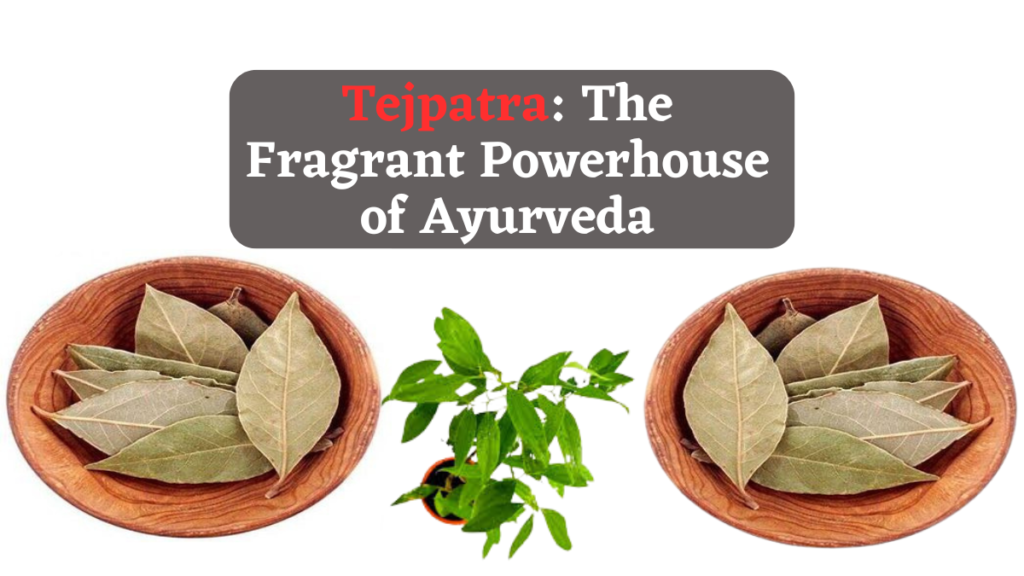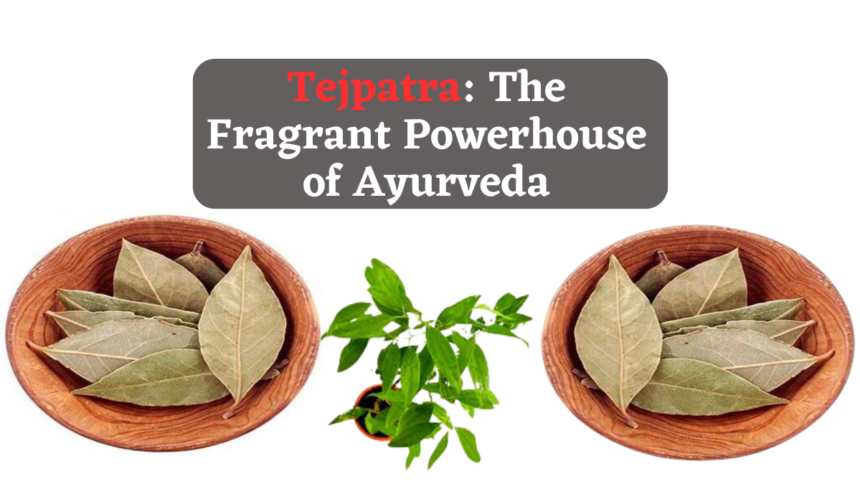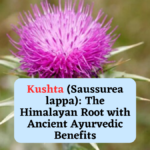Tejpatra: The Fragrant Powerhouse of Ayurveda
Introduction
Tejpatra, also known as Indian bay leaf, is a common ingredient gracing kitchens across India. Its warm, aromatic fragrance adds depth and complexity to curries, dals, and biryanis. But beyond its culinary magic, Tejpatra boasts a rich history in Ayurveda, the ancient Indian system of medicine. Let’s delve into the multifaceted world of Tejpatra and explore its potential health benefits through the lens of Ayurveda.

Tejpatra’s Ayurvedic Properties:
Ayurveda categorizes herbs based on their energetic qualities (gunas) and taste (rasa). Tejpatra is considered:
- Laghu (light): It’s easy to digest and doesn’t weigh down the digestive system.
- Ruksha (dry): It can help balance Kapha dosha, which is associated with water and earth elements.
- Katu (pungent): This taste is believed to stimulate digestive fire (agni) and improve circulation.
- Ushna (hot): Its warming property can be beneficial for individuals with Vata imbalances, characterized by coldness and dryness.
Potential Ayurvedic Benefits of Tejpatra:
- Digestive Aid: Tejpatra’s carminative properties are believed to aid digestion by reducing bloating and gas. Its enzymatic action may also help break down food particles for better nutrient absorption.
- Respiratory Support: The warming and expectorant properties of Tejpatra can help clear congestion and soothe coughs associated with Kapha imbalances.
- Pain Relief: Tejpatra’s anti-inflammatory properties may provide relief from aches and pains, particularly those associated with Vata dosha.
- Aromatic Benefits: Inhaling the aroma of Tejpatra is believed to have calming and stimulating effects, promoting mental clarity and focus.
How to Use Tejpatra in Ayurveda:
Traditionally, Tejpatra is used whole in cooking. However, in some cases, Ayurvedic practitioners may recommend consuming Tejpatra powder in small doses (¼ – ½ teaspoon) mixed with honey or ghee. It’s important to consult with a qualified Ayurvedic doctor before using Tejpatra medicinally to determine the appropriate dosage and form for your specific needs and constitution.
Important Considerations:
While Tejpatra is generally safe for most individuals, it’s advisable to exercise caution in certain situations:
- Pitta Imbalance: Individuals with a dominant Pitta dosha may experience increased heat due to Tejpatra’s Ushna (hot) property. Moderation is key.
- Pregnancy and Lactation: The safety of Tejpatras for pregnant and lactating women is not fully established. It’s best to consult with a healthcare provider before use.
Conclusion:
Tejpatra is more than just a flavorful culinary companion. It’s a versatile herb with a rich history in Ayurveda. By understanding its properties and potential benefits, you can integrate Tejpatras into your Ayurvedic routine to promote overall well-being and experience the power of this fragrant powerhouse. Remember, consulting a qualified Ayurvedic practitioner is essential for personalized guidance and safe use
Tejpatra (Indian Bay Leaf) in Ayurveda: Frequently Asked Questions
What are the benefits of Tejpatra according to Ayurveda?
Ayurveda suggests Tejpatra may offer various benefits, including:
- Improved Digestion: Its carminative properties may help reduce bloating and gas, aiding digestion.
- Respiratory Support: Its warming and expectorant qualities might help clear congestion and soothe coughs.
- Pain Relief: Anti-inflammatory properties may provide relief from aches and pains, especially Vata-related ones.
- Mental Wellness: The aroma is believed to have calming and stimulating effects, promoting mental clarity and focus.
How is Tejpatra used in Ayurveda?
Traditionally, Tejpatra is used whole in cooking. In some cases, an Ayurvedic doctor might recommend consuming small doses (¼ – ½ teaspoon) of Tejpatra powder mixed with honey or ghee. However, consulting a qualified practitioner is crucial to determine the appropriate dosage and form for your specific needs.
Are there any side effects to using Tejpatra?
Tejpatra is generally safe, but some precautions exist:
- Pitta Imbalance: People with dominant Pitta dosha may experience increased heat due to Tejpatra’s warming nature. Moderation is key.
- Pregnancy and Lactation: Safety during pregnancy and breastfeeding is not fully established. Consult a healthcare provider before use.
How can I learn more about using Tejpatra in Ayurveda?
- Consult a qualified Ayurvedic practitioner for personalized guidance on incorporating Tejpatra into your routine.
- Look for reputable Ayurvedic resources online or in libraries, focusing on reliable sources with proper citations.
Can Tejpatra cure diseases?
Ayurveda emphasizes promoting overall well-being and preventing imbalances. While Tejpatra may offer potential benefits, it’s not a cure-all. It may be used alongside conventional medicine in some cases.
Where can I find a qualified Ayurvedic practitioner?
Look for practitioners certified by recognized Ayurvedic organizations. You can also ask your doctor for recommendations.











